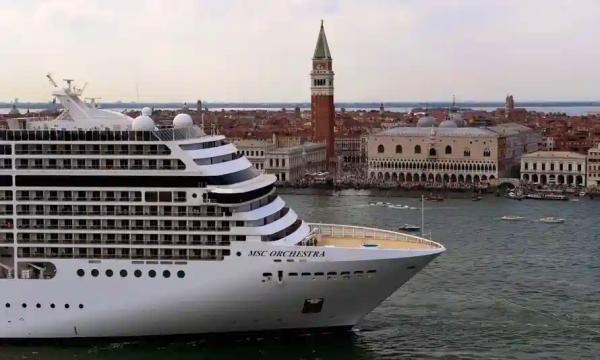 The Italian government is banning large cruise ships from calling on the Venice lagoon after declaring the lagoon a national monument. Italy had come under pressure from Unesco, the UN’s heritage agency, that threatened to put Venice on its endangered list unless the government permanently banned cruise ships from docking in the world heritage site. The ban is an attempt to protect the lagoon’s fragile ecosystem from the downsides of mass tourism. As of August 1, 2021, no passenger vessel above 25,000 register tonnes will be allowed to dock in the lagoon.
The Italian government is banning large cruise ships from calling on the Venice lagoon after declaring the lagoon a national monument. Italy had come under pressure from Unesco, the UN’s heritage agency, that threatened to put Venice on its endangered list unless the government permanently banned cruise ships from docking in the world heritage site. The ban is an attempt to protect the lagoon’s fragile ecosystem from the downsides of mass tourism. As of August 1, 2021, no passenger vessel above 25,000 register tonnes will be allowed to dock in the lagoon.
Cruise ships as large as 139,000 tonnes have called on Venice in the recent past. In 2019, the 65,591-tonne ship, MSC Opera lost control while docking on the Giudecca Canal in Venice, slamming into the dock and hitting a tour boat, injuring five people. The ship was accompanied by two tugs that were nevertheless unable to control the 2,150 passenger ship.
Last month, the 92,000-tonne MSC Orchestra sailed from the Giudecca Canal, prompting protests by hundreds on land and small boats fluttering flags saying “No big ships.”
The 25,000-tonne limit means only small passenger ferries and freight vessels will be able to use the Giudecca canal to enter Venice’s historic center.
The current plan is for cruise ships to dock at the industrial port of Marghera, about 10 miles from Venice. Unfortunately, the infrastructure of the new cruise terminal has yet to be completed. The Guardian reports that the government has appointed a commissioner to fast-track the job, which would ordinarily take about six months. Meanwhile, a call for bids for the construction of a terminal equipped to take ships of more than 40,000 tonnes was published at the end of June.

Good!! About time.
I agree with Roger, whilst the Cruise ships create very little wash compared to the fast launches in the lagoon they are so out of context and the possibility of one having steering problems and damaging historic buildings like in Turkey is too much of a risk.
My guess is that the cruise ships’ pod propulsion aft and the thrusters forward could do considerable damage to the canal bottom and seawalls.